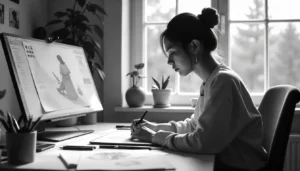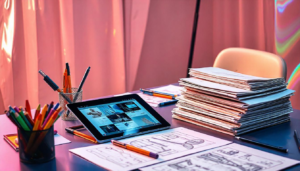
Embarking on the journey to become a 2D game artist is an exciting and rewarding adventure. Whether you’re passionate about creating captivating characters, immersive environments, or stunning visual effects, the path to growth involves continuous learning and practice. Here’s a personal guide to help you get started and thrive in the world of 2D game art.
1. Discover Your Passion
Every artist’s journey begins with a love for art. Think about what drew you to 2D game art in the first place. Was it the enchanting worlds of your favorite games, the characters that felt so real, or the desire to create something uniquely yours? Embrace that passion and let it fuel your creativity.
2. Build a Strong Foundation
Start by honing your artistic skills. A formal degree, however not mandatory, can be inspiring by taking courses in fine arts, graphic design, or animation can provide a solid foundation. Learn the basics of color theory, composition, and anatomy. These fundamentals will be the building blocks of your art.

3. Get Comfortable with Digital Tools
As a 2D game artist, you’ll spend a lot of time with digital tools. Familiarize yourself with software like Adobe Photoshop, Illustrator, and After Effects. These programs will be your best friends in creating game assets. Don’t be afraid to experiment and find the tools that work best for you.
4. Create a Portfolio that Tells Your Story
Your portfolio is a reflection of your journey as an artist. Include your best work, from concept art to character designs and environment art. Make sure it’s accessible online and regularly updated. Your portfolio should showcase your growth and the unique style that sets you apart.
5. Gain Real-World Experience
Experience is invaluable. Start with small projects, freelance work, or participate in game jams. These opportunities allow you to apply your skills, collaborate with others, and understand the game development process. Each project is a stepping stone, teaching you something new.
6. Connect with the Community
The gaming community is a supportive and inspiring place. Attend game development conferences, join online forums, and participate in social media groups dedicated to game art. Networking with other artists and developers can lead to collaborations, job offers, and valuable feedback.
7. Keep Learning and Evolving
The gaming industry is always changing. Stay updated by following industry news, taking online courses, and experimenting with new software and styles. Continuous learning and adaptation are key to staying relevant and growing as a 2D game artist.

8. Embrace Feedback and Iterate
Constructive feedback is essential for growth. Share your work with peers, mentors, and online communities to receive critiques and suggestions. Use this feedback to improve your skills and refine your art. Remember, every piece of feedback is an opportunity to learn and grow.
9. Find Your Unique Voice
While it’s important to learn from others, developing your unique style will set you apart. Experiment with different techniques, themes, and aesthetics to find what resonates with you. Your distinctive style will become your signature, making your work recognizable and memorable.
Growing as a 2D game artist is a journey filled with creativity, challenges, and immense satisfaction. By building a strong foundation, mastering essential tools, gaining practical experience, and continuously seeking feedback, you can carve out a successful career in the gaming industry. Embrace the journey, stay passionate, and let your creativity shine through your art.
Start your
Development Journey!


